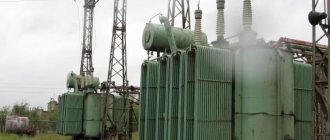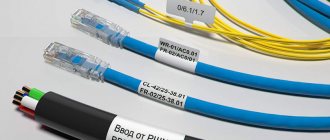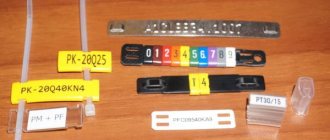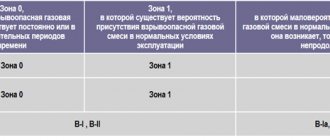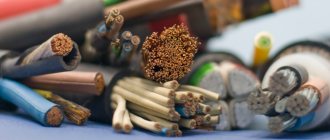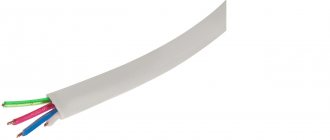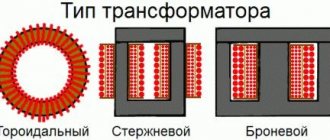We have prepared for you a decoding of the markings of cables and wires with a table so that you can conveniently interact with it during installation and operation. Signs are placed on them so that the consumer knows what kind of cord it is and what is inside it. All these numbers, letters and colored lines are applied to the product at the factory to separate brands with some characteristics from their counterparts with other functions. To understand this issue, read and apply certain rules.
Purpose of marking
Most consumers, when faced with markers for the first time, do not understand what these numbers and letters in the composition mean. There are different models on the market: both domestic and foreign, which indicate:
- The material used to make the wire cores, as well as their number. Often created from aluminum and copper. Multicore conductors. There are unusual varieties in which these elements are made of steel or composite.
- Type of insulation. This designation tells what the insulating shell of all layers is made of. This can be polyvinyl chloride, rubber, fluoroplastic and other materials.
- Section. The indicator shows the area of the current-carrying part when viewed through a cross section. It determines how much resistance the conductor will provide to electric current. The standard ranges from 0.35 to 240 mm.
- Area of use. A mandatory mark that will tell you how resistant the wire will be to an aggressive environment.
- Design features. Noting additional items or unusual materials used. Sometimes it is an indicator of the specificity of manufacturing technologies.
- How flexible. Indicates how well this instance will bend. Marked from 1 to 6, where 1 shows no flexibility, and 6 bends as much as possible.
- Electricity is at par. Separates the operating voltage for which the insulation is calculated.
The most important differences
Wire markings for electrical wiring and other purposes are made to indicate certain design features that correspond to the type of product.
According to this division, it is a product of a monolith or stranded current-carrying part, which is capable of incorporating insulating layers or functioning without them.
An electrical cord consists of conductive elements with insulated layers; inside it has a multi-wire structure for connecting to the power supply of devices.
It is sold in the form of single-core and with a large number of cores. It has more than 2 layers of insulating gasket, there is an armor screen and other particles, their presence and quantity depends on the design and purpose - communication, control, power and radio frequency.
If we take into account the above division, we can understand what lies in front of the client. For a knowledgeable person, one glance at a wire is enough to understand what its role is in a particular electronic installation. To make this clear, we propose to analyze all the designations of common models in devices.
Common labeling mistakes
Let's list three main mistakes:
- The most common one is caused by novice electricians or experienced specialists due to inattention. In the process of screwing the wire to the shield and terminals, the craftsmen simply forget to put a heat-shrinkable tube with markings (tube) on the wires. Because of this, you have to unscrew the attached wiring and put the products on again.
- Often craftsmen confuse the PEN conductor with a grounding cable. The fact is that both elements have identical color markings, so you need to inspect them more carefully.
- If the panel is located outside the site, then it is necessary to conclude an agreement with the electrical energy supplier. You must have on hand technical documentation with a diagram and confirmation of compliance with the requirements of the PUE, PTEEP and other regulatory acts. Otherwise, you may face claims from Rostekhnadzor.
Let's summarize: in accordance with the requirements and regulations prescribed in international and domestic standards, all power installations and cable lines without exception must be marked. The need for marking is not affected by either the voltage values or the location of installation (laying) of the circuit.
Qualified specialists will agree to carry out repair work and engage in maintenance of emergency areas only if sufficient information about the parameters of the line is provided. This is exactly what is contained on the cable tags.
Alphanumeric markers
Most of the cables have letters and numbers on their surface. Each is responsible for a specific function or purpose. Symbols are necessary because there are special regulations for manufacturers, confirmed by regulatory documents.
It is worth noting that in modern conditions everything is created not according to standards, but according to technical conditions. What will be written may vary greatly depending on the field.
Designation of markings of power cables and electrical wires and their interpretation
These models differ in their characteristics - they contain conductors with a cross-section that can power the equipment. But remember that such equipment includes household consumers and at the same time serious devices in enterprises with enormous power.
To correctly decipher the letters on the surface, we provide a small list:
- If it starts with marker A, then the main part is aluminum. The absence of "A" indicates a copper element.
- B – stands after A or first if there is no A. Indicates the presence of insulation around a live part.
- B - reports a PVC insulating layer, can appear after the previous characters or 1 in the list.
- P - means that there is rubber around the core. HP subtype - will not support combustion.
- P – is responsible for the polyethylene sheath; in the case of cable products, this is a thermoplastic variety. They write Ps if it is self-extinguishing, Pv if it is vulcanized.
- If AC or AA are combined, then the second symbol means aluminum winding, and C means lead winding.
- K – armored galvanized steel under the hose part, but it is designated this way only if the abbreviation does not begin with it. If this is the first character, then it indicates that we have a control cable.
- B features an armored section made of a steel plate. If it has the addition Bn, then it is armor with a non-flammable coating, otherwise there is no cushion.
- G – if the letter is large, it means that this brand can be installed even in mine workings.
- d – small indicates that there is sealing. Usually the sealing layer is made with water-repellent tapes. 2g is an aluminum polymer base.
- Shv, Shp and Shps indicate that the coating is made of PVC, polyethylene or non-flammable hose.
- O - signals that everyone will have their own shell.
- ng - symbolizes that the material does not burn and does not burn in any way.
- E - if it is at the very beginning, then this is a model that will withstand placement in a mine and with particularly aggressive conditions.
For control models
Able to transmit a control signal to any device to which it is connected. It is used when it is important to obtain accurate data.
Explanation of the designation of the cross-section of cables and various wires of this category:
- K – belonging to the control group. It can stand in either 1st or 2nd place, indicating the material of the core.
- A – indicates the presence of aluminum. If there is no symbol, then the option in front of you is copper core.
- B - denotes polyvinyl chloride as insulation near the live part.
- c – the outer side is made of the same material.
- P - makes it clear that the insulating element was formed from polyethylene.
- F – fluoroplastic layer.
- P - indicates the presence of rubber as an insulator. HP is a rubber shell that will not support combustion.
- G – confirms that the selected model is naked.
- E - if not at the beginning of the line, then this is the screen in the composition.
It is worth noting that the KG coding usually marks not the cord for controlling devices, but the flexible cable.
For contact
For these lines, they came up with special brands that have their own markings for cable products and electrical wires. In standard cases, these are examples for small current, which have a small cross-section and a large number of pairs.
Descriptions are registered on them:
- T – telephone;
- P – polyethylene insulation;
- p – waist insulating material made of PVC or polyethylene terephthalate;
- P - if they come in a row, then this is an additional protective shell;
- E – screen, this is one of the elements required for signalmen;
- Z - indicates that there is a hydrophobic filler that will retain penetrating moisture;
- C – used only on railways.
How to decipher a digital designation
Usually 3 digits are used, which take on the parameters:
- how many lived - there is 1 or many, each is marked;
- cross-section - if there are conductors with different indicators, they are marked separately;
- shows the nominal voltage, but it is not always there.
How wires and various cords are marked
The principle by which markers will be placed on them differs from that used for cables. All requirements are specified in GOST 7399-97.
In this area, AC will mean that it is an aluminum core with a steel core. We are not talking about isolation here.
SIP will mean a product that has several types, it is self-supporting and at the same time insulated.
PPV indicates the presence of a flat core and an insulating layer of polyvinyl chloride.
MG is a flexible copper product.
These are only private variants of the most commonly used names. But you can find a lot of foreign options that will differ in markers.
What types of wires are there?
Telephone calls, all kinds of information, industrial-sized and household electricity are transmitted through wires today. Depending on what work the wire performs, it differs in metal and core diameter, number of cores, insulation, and special qualities. In places of increased fire danger, for example, cables or cords are laid with insulation that does not burn well. All these nuances have a specific designation in the form of letters and numbers indicated on the insulation of electrical wires.
Decoding the wire markings is a brief listing of the technical characteristics of the product. Each letter of the marking indicates:
- the metal from which the central cores are made, directly passing electric current;
- place of use of this product;
- insulation and general shell material, additional protection;
- degree of flexibility, fire resistance, self-extinguishing ability, low smoke emission, non-flammable;
- type of structure, number of cores;
- total cross-sectional area of wires, cores;
- the optimal voltage that the product can withstand in operating mode.
Ready-made solutions for all areas
Stores
Mobility, accuracy and speed of counting goods on the sales floor and in the warehouse will allow you not to lose days of sales during inventory and when receiving goods.
To learn more
Warehouses
Speed up your warehouse employees' work with mobile automation. Eliminate errors in receiving, shipping, inventory and movement of goods forever.
To learn more
Marking
Mandatory labeling of goods is an opportunity for each organization to 100% exclude the acceptance of counterfeit goods into its warehouse and track the supply chain from the manufacturer.
To learn more
E-commerce
Speed, accuracy of acceptance and shipment of goods in the warehouse is the cornerstone in the E-commerce business. Start using modern, more efficient mobile tools.
To learn more
Institutions
Increase the accuracy of accounting for the organization’s property, the level of control over the safety and movement of each item. Mobile accounting will reduce the likelihood of theft and natural losses.
To learn more
Production
Increase the efficiency of your manufacturing enterprise by introducing mobile automation for inventory accounting.
To learn more
RFID
The first ready-made solution in Russia for tracking goods using RFID tags at each stage of the supply chain.
To learn more
EGAIS
Eliminate errors in comparing and reading excise duty stamps for alcoholic beverages using mobile accounting tools.
To learn more
Certification for partners
Obtaining certified Cleverence partner status will allow your company to reach a new level of problem solving at your clients’ enterprises.
To learn more
Inventory
Use modern mobile tools to carry out product inventory. Increase the speed and accuracy of your business process.
To learn more
Mobile automation
Use modern mobile tools to account for goods and fixed assets in your enterprise. Completely abandon accounting “on paper”.
Learn more Show all automation solutions
Cables ng(A)-FRLS and ng(A)-FRHF
ng(A)-FRLS – fire-resistant cable, flame retardant when laid in groups, with low smoke and gas emission (Fire Resistant Low Smoke)
ng(A)-FRHF – fire-resistant cable, flame retardant when laid in groups, with low smoke and gas emission and low corrosive activity, halogen-free (Fire Resistant Halogen Free)
The indices ng(A)-FRLS and ng(A)-FRHF are interchangeable; you can use one or the other.
ng(A)-FRLS and ng(A)-FRHF cables are used in fire protection systems (fire alarms, warning and evacuation control, etc.) at all facilities except those listed in Table 2 of GOST 31565-2012.
Other systems that must operate in case of fire are specified in Federal Law-123:
Federal Law-123 article 82 paragraph 2
The article was prepared on the basis of the webinar “Selection of cable products for SPZ and selection of OKL. Part 2"
Color coding
To further separate the electrical wires, different colors are used. If a person does twists not for the first time, it will not be difficult for him to almost automatically figure out what is responsible for what. Standards are used in production, so it becomes possible to complete the installation for another person.
A few important color options:
- grounding or “earth” – greenish-yellow, blue-black, white (not always);
- zero – blue or cyan;
- the combined conductor is yellowish-green with splashes of blue.
The shade of the “phase” may vary from one manufacturer to another, but not much. In this case, you have to focus on the “ground” option.
Cables ng(A)-LSLTx and ng(A)-HFLTx
ng(A)-LSLTx – do not propagate combustion when laid in groups, beam category “A”, with low smoke and gas emission (Low Smoke) and low toxicity of combustion products (Low Toxicity)
Developed in Russia, there are no low-toxic cables in Europe. The developers of Federal Law-123 and GOST 31565-2012 are very proud that they managed to implement these fire safety requirements.
Section 6 table 2 GOST 31565-2012
The ng(A)-LSLTx index has a narrow specialization and is used only in kindergartens, schools, hospitals, nursing homes, in dormitory buildings of boarding educational institutions and children's institutions.
ng(A)-HFLTx - do not propagate combustion when laid in groups, with low corrosiveness of combustion products (Halogen Free), low toxicity of combustion products (Low Toxicity)
ng(A)-HFLTx is not confirmed by any manufacturer, so you will not find it anywhere, because There are no materials on the market yet that are tested for both low corrosiveness and low toxicity of combustion products.
Relatively recently, Lan cables from European and Chinese manufacturers with indexes and descriptions ng(A)-HFLTx began to appear. In most cases, these certificates are questionable, because... the cables could not pass the HF low toxicity tests without materials not yet on the market. The certificates of these manufacturers for ng(A)-HFLTx are voluntary, and this is a gross violation, because Cable fire safety certification is mandatory. Voluntary certification can only prove that the cable does not spread fire when laid in groups, but does not make it possible to indicate the fire hazard class of the cable, because no real tests have been carried out.
At the moment, ng(A)-HFLTx that has passed mandatory compliance certification cannot be found. If you come across an ng(A)-HFLTx cable with a certificate, try not to include it in your project.
Cables ng(A)-FRLSLTx and ng(A)-FRHFLTx
ng(A)-FRLSLTx – fire-resistant low-toxicity cable, flame retardant when laid in groups, with low corrosive activity (Fire Resistant Low Smoke Low Toxic)
Section 6 table 2 GOST 31565-2012
Everything here is the same as with the above-mentioned ng(A)-LSLTx and ng(A)-HFLTx cables for kindergartens, hospitals, etc., but with one significant difference - cables with the FR prefix are used for fire protection systems and other systems that must operate in case of fire.
Tables
We suggest you look at what different brands of wires and cables for electrical wiring will look like and their interpretation in the table.
The principle of labeling foreign products
| What does it look like in the standard | Deciphering | |
| Type | ||
| N | Power | |
| H | agreed upon | |
| Rated voltage | ||
| 03 | 300V | |
| 05 | 300/500V | |
| 07 | 450/750V | |
| The core that carries the current | ||
| Cu | Copper | |
| A, AL | Aluminum | |
| Insulation layer | ||
| Y,PVC | Polyvinyl chloride | |
| V | ||
| G | Rubber material | |
| R | ||
| N | Polychloroprene rubber | |
| S | Rubberized Silicone Matter | |
| 2Y | Polyethylene | |
| 02Y | Polyethylene that has been foamed | |
| 02YS | ||
| XLPE, 2X | Polyethylene, which has a porous film-foam structure | |
| Semiconductor | ||
| H | semiconductive | |
| Screen | ||
| C, S | Copper screen | |
| A | Aluminum foil | |
| F | The presence of a hydrophobic filler in the cable core | |
| F(Y)2Y | In addition to the above, aluminum shell | |
Design features of power cables
| Brand | Cores made of (A)aluminum or (M)edium | Insulating layer, where P is polyethylene | Shell made of (P) polyethylene, V-PVC regular, Vng its non-flammable analogue | Is there protection |
| APVG | A | P | IN | No |
| AVVG | A | IN | IN | No |
| VVG | M | IN | IN | No |
| AVVGng | A | IN | Vng | No |
| VVGng | M | IN | Vng | No |
| AVVGz | A | B (filler included) | IN | No |
| VVGz | M | B (filler included) | V | No |
| AVBbShv | A | IN | No | BbShv |
| VBBShv | M | IN | No | BbShv |
| AVBbShng | A | IN | No | BbShng |
| VBBShng | M | V | No | BbShng |
| AVVB | A | V | IN | B |
| VVB | M | V | IN | B |
Design features of control cables
| Brand | Cores made of (A)aluminum or (M)edium | Insulating layer, where P is polyethylene | Shell made of (P) polyethylene, V-PVC regular, Vng its non-flammable analogue | Is there protection |
| AKPVG | A | P | IN | No |
| KPVG | M | P | IN | No |
| AKVVG | A | IN | IN | No |
| KVVG | M | IN | V | No |
| AKVVGng | A | IN | Vng | No |
| KVVGng | M | IN | Vng | No |
| AKVVGz | A | B (with filler) | IN | No |
| KVVGz | M | B (with filler) | IN | No |
| AKVBBShv | A | IN | No | BbShv |
| KVBBbShv | M | IN | No | BbShv |
What technical indicators do cords and wires have?
| Brand | Number and nominal cross-section of cores, mm2 | Core class according to GOST not lower, or design | Nominal thickness, mm | External dimensions, mm | Electrical insulation resistance at 70 °C, MOhm per 1 km, not less | ||
| isolation | shell | min | Max. | ||||
| SHOG | — | Two strands of tinsel threads | 0,8 | — | 2,2×4,4 | 3,5×7,0 | 0,019 |
| ShVP-2 | 2×0,35 | 5 | 0,8 | — | 2,2×4,5 | 2,6×5,2 | 0,016 |
| 2×0,50 | 0,5×5,0 | 3,0×6,0 | 0,016 | ||||
| 2×0,75 | 2,7×5,4 | 3,2×6,4 | 0,014 | ||||
| Ball screw | 2×0,50 | 6 | 0,8 | — | 2,5×5,0 | 3,0×6,0 | 0,016 |
| 2×0,75 | 2,7×5,4 | 3,2×6,4 | 0,014 | ||||
| SHVD | 1×0,50 | 6 | 0,8 | — | 2,3 | 2,7 | 0,016 |
| 1×0,75 | 2,6 | 2,9 | 0,014 | ||||
| GDP | 2×0,50 | 5 | 0,5 | 0,6 | 3,0×4,8 | 3,6×6,0 | 0,012 |
| 2×0,75 | 3,2×5,2 | 3,9×6,4 | 0,010 | ||||
| 3×0,50 | 3,0×6,7 | 3,3×7,4 | 0,012 | ||||
| 3×0,75 | 3,2×7,4 | 3,6×8,2 | 0,010 | ||||
| ShVL | 2×0,50 | 5 | 0,5 | 0,6 | 4,8 | 6,0 | 0,012 |
| 2×0,75 | 5,2 | 6,4 | 0,010 | ||||
| 3×0,50 | 5,0 | 6,2 | 0,012 | ||||
| 3×0,75 | 5,4 | 6,8 | 0,010 | ||||
| ShPS | 2×0,50 | 4 | 0,5 | 0,8 | 5,1 | 5,7 | 0,012 |
| 2×0,75 | 3 | 5,5 | 6,1 | 0,010 | |||
| 3×0,50 | 4 | 5,4 | 6,0 | 0,012 | |||
| 3×0,75 | 3 | 5,8 | 6,4 | 0,010 | |||
| SHVG | 2×0,50 | 5 | 0,5 | 0,8 | 5,1 | 6,0 | 0,012 |
| 2×0,75 | 5,6 | 6,6 | 0,010 | ||||
| 3×0,50 | 5,4 | 6,4 | 0,012 | ||||
| 3×0,75 | 5,9 | 6,9 | 0,010 | ||||
| 4×0,50 | 5,9 | 6,9 | 0,012 | ||||
| 4×0,75 | 6,0 | 7,0 | 0,010 | ||||
| PVS | 2×0,75 | 5 | 0,6 | 0,8 | 6,0 | 7,6 | 0,011 |
| 2×1,00 | 0,6 | 0,8 | 6,4 | 8,0 | 0,010 | ||
| 2×1,50 | 0,7 | 0,8 | 7,4 | 9,0 | 0,010 | ||
| 2×2,50 | 0,8 | 1,0 | 8,9 | 11,0 | 0,009 | ||
| 3×0,75 | 0,6 | 0,8 | 6,4 | 8,0 | 0,011 | ||
| 3×1,00 | 0,6 | 0,8 | 6,8 | 8,4 | 0,010 | ||
| 3×1,50 | 0,7 | 0,9 | 8,0 | 9,8 | 0,010 | ||
| 3×2,50 | 0,8 | 1,1 | 9,6 | 12,0 | 0,009 | ||
| 4×0,75 | 0,6 | 0,8 | 6,8 | 8,6 | 0,011 | ||
| 4×1,00 | 0,6 | 0,9 | 7,6 | 9,4 | 0,010 | ||
| 4×1,50 | 0,7 | 1,0 | 9,0 | 11,0 | 0,010 | ||
| 4×2,50 | 0,8 | 1,1 | 10,5 | 13,0 | 0,009 | ||
| 5×0,75 | 0,6 | 0,9 | 7,4 | 9,6 | 0,011 | ||
| 5×1,00 | 0,6 | 0,9 | 8,3 | 10,0 | 0,010 | ||
| 5×1,50 | 0,7 | 1,1 | 10,0 | 12,0 | 0,010 | ||
| 5×2,50 | 0,8 | 1,2 | 11,5 | 14,0 | 0,009 | ||
| PVSP | 2×0,75 | 5 | 0,6 | 0,8 | 3,8×6,0 | 5,2×7,6 | 0,011 |
| ShR | 2×0,50 | 6 | 0,8 | — | 4,9 | 6,8 | — |
| 2×0,75 | — | 5,4 | 7,3 | — | |||
| 2×1,00 | — | 5,7 | 7,5 | — | |||
| 2×1,50 | — | 6,3 | 8,3 | — | |||
| ShRO | 2×0,50 | 5 | 0,8 | — | 5,7 | 7,7 | — |
| 2×0,75 | — | 5,8 | 8,0 | — | |||
| 2×1,00 | — | 6,2 | 8,4 | — | |||
| 2×1,50 | — | 6,8 | 9,0 | — | |||
| 3×0,50 | — | 6,0 | 7,0 | — | |||
| 3×0,75 | — | 6,2 | 8,6 | — | |||
| 3×1,00 | — | 6,6 | 9,0 | — | |||
| 3×1,50 | — | 7,2 | 9,6 | — | |||
| PRS | 2×0,75 | 5 | 0,6 | 0,8 | 6,0 | 8,2 | — |
| 2×1,00 | 0,6 | 0,9 | 6,6 | 8,8 | — | ||
| 2×1,50 | 0,8 | 1,0 | 8,0 | 10,5 | — | ||
| 2×2,50 | 0,9 | 1,1 | 9,5 | 12,5 | — | ||
| 2×4,00 | 1,0 | 1,2 | 11,5 | 14,0 | — | ||
| 3×0,75 | 0,6 | 0,9 | 6,5 | 8,8 | — | ||
| 3×1,00 | 0,6 | 0,9 | 7,0 | 9,2 | — | ||
| 3×1,50 | 0,8 | 1,0 | 8,6 | 11,2 | — | ||
| 3×2,50 | 0,9 | 1,1 | 10,0 | 13,0 | — | ||
| 3×4,00 | 1,0 | 1,2 | 12,0 | 14,5 | — | ||
| 4×0,75 | 0,6 | 0,9 | 7,1 | 9,6 | — | ||
| 4×1,00 | 0,6 | 0,9 | 7,6 | 10,0 | — | ||
| 4×1,50 | 0,8 | 1,1 | 9,6 | 12,5 | — | ||
| 4×2,50 | 0,9 | 1,2 | 11,0 | 14,0 | — | ||
| 4×4,00 | 1,00 | 1,3 | 13,5 | 16,5 | — | ||
| 5×0,75 | 0,6 | 1,0 | 8,0 | 11,0 | — | ||
| 5×1,00 | 0,6 | 1,0 | 8,5 | 11,5 | — | ||
| 5×1,50 | 0,8 | 1,1 | 10,5 | 13,5 | — | ||
| 5×2,50 | 0,9 | 1,3 | 12,5 | 15,5 | — | ||
| PRM | 2×0,75 | 5 | 0,6 | 0,8 | 6,0 | 8,2 | — |
| 2×1,00 | 0,6 | 0,9 | 6,6 | 8,3 | — | ||
| 2×1,50 | 0,8 | 1,0 | 8,0 | 10,5 | — | ||
| 2×2,50 | 0,9 | 1,1 | 9,5 | 12,5 | — | ||
| 3×0,75 | 0,6 | 0,9 | 6,5 | 8,8 | — | ||
| 3×1,00 | 0,6 | 0,9 | 7,0 | 9,2 | — | ||
| 3×1,50 | 0,8 | 1,0 | 8,6 | 11,0 | — | ||
| 3×2,50 | 0,9 | 1,1 | 10,0 | 13,0 | — | ||
| 4×0,75 | 0,6 | 0,9 | 7,1 | 9,6 | — | ||
| 4×1,00 | 0,6 | 0,9 | 7,6 | 10,6 | — | ||
| 4×1,50 | 0,8 | 1,1 | 9,6 | 12,5 | — | ||
| 4×2,50 | 0,9 | 1,2 | 11,0 | 14,0 | — | ||
| 5×0,75 | 0,6 | 1,0 | 8,0 | 11,0 | — | ||
| 5×1,00 | 0,6 | 1,0 | 8,5 | 11,5 | — | ||
| 5×1,50 | 0,8 | 1,1 | 10,5 | 13,5 | — | ||
| 5×2,50 | 0,9 | 1,3 | 12,5 | 15,5 | — | ||
| PSG | 1×1,50 | 5 | 0,8 | 1,4 | 5,8 | 7,2 | — |
| 1×2,50 | 0,9 | 1,4 | 6,4 | 8,0 | — | ||
| 1×4,00 | 1,0 | 1,5 | 7,4 | 9,0 | — | ||
| 1×6,00 | 1,0 | 1,6 | 8,0 | 11,0 | — | ||
| 1×10,0 | 1,2 | 1,8 | 9,8 | 12,5 | — | ||
| 1×16,0 | 1,2 | 1,9 | 11,0 | 14,5 | — | ||
| 1×25,0 | 1,4 | 2,0 | 12,5 | 16,5 | — | ||
| 1×35,0 | 1,4 | 2,2 | 14,0 | 18,5 | — | ||
| 1×50,0 | 1,6 | 2,4 | 16,6 | 21,0 | — | ||
| 1×70,0 | 1,6 | 2,6 | 18,5 | 23,5 | — | ||
| 1×95,0 | 1,8 | 2,6 | 21,0 | 26,0 | — | ||
| 1×120 | 1,8 | 3,0 | 23,5 | 28,5 | — | ||
| 1×150 | 2,0 | 3,2 | 26,0 | 31,5 | — | ||
| 1×185 | 2,2 | 3,4 | 27,5 | 34,5 | — | ||
| 1×240 | 2,4 | 3,5 | 30,5 | 38,0 | — | ||
| 1×300 | 2,6 | 3,6 | 33,5 | 41,5 | — | ||
| 1×400 | 2,8 | 3,8 | 37,5 | 46,5 | — | ||
| 2×1,00 | 0,8 | 1,3 | 8,0 | 10,5 | — | ||
| 2×1,50 | 0,8 | 1,5 | 9,0 | 11,5 | — | ||
| 2×2,50 | 0,9 | 1,7 | 10,5 | 13,5 | — | ||
| 2×4,00 | 1,0 | 1,8 | 12,0 | 15,0 | — | ||
| 2×6,00 | 1,0 | 2,0 | 13,5 | 18,5 | — | ||
| 2×10,0 | 1,2 | 3,1 | 18,5 | 24,0 | — | ||
| 2×16,0 | 1,2 | 3,3 | 21,0 | 27,5 | — | ||
| 2×25,0 | 1,4 | 3,6 | 25,0 | 31,5 | — | ||
| 3×1,00 | 0,8 | 1,4 | 8,6 | 11,5 | — | ||
| 3×1,50 | 0,8 | 1,6 | 9,6 | 12,5 | — | ||
| 3×2,50 | 0,9 | 1,8 | 11,5 | 14,5 | — | ||
| 3×400 | 1,0 | 1,9 | 13,0 | 16,0 | — | ||
| 3×6,00 | 1,0 | 2,1 | 14,5 | 20,0 | — | ||
| 3×10,0 | 1,2 | 3,3 | 20,0 | 25,0 | — | ||
| 3×16,0 | 1,2 | 3,5 | 22,5 | 29,5 | — | ||
| 3×25,0 | 1,4 | 3,8 | 26,5 | 34,0 | — | ||
| PSG | 3×35,0 | 5 | 1,4 | 4,1 | 29,5 | 38,0 | — |
| 3×50,0 | 1,6 | 4,5 | 34,5 | 44,0 | — | ||
| 3×70,0 | 1,6 | 4,8 | 39,0 | 49,5 | — | ||
| 3×95,0 | 1,8 | 5,3 | 44,0 | 54,0 | — | ||
| 4×1,00 | 0,8 | 1,5 | 9,6 | 12,5 | — | ||
| 4×1,50 | 0,8 | 1,7 | 10,5 | 13,5 | — | ||
| 4×2,50 | 0,9 | 1,9 | 12,5 | 15,5 | — | ||
| 4×4,00 | 1,0 | 2,0 | 14,5 | 18,0 | — | ||
| 4×6,00 | 1,0 | 2,3 | 16,5 | 22,0 | — | ||
| 4×10,0 | 1,2 | 3,4 | 21,5 | 28,0 | — | ||
| 4×16,0 | 1,2 | 3,6 | 24,5 | 32,0 | — | ||
| 4×25,0 | 1,4 | 4,1 | 29,5 | 37,5 | — | ||
| 4×35,0 | 1,4 | 4,4 | 33,0 | 42,0 | — | ||
| 4×50,0 | 1,6 | 4,8 | 38,0 | 48,5 | — | ||
| 4×70,0 | 1,6 | 5,2 | 43,0 | 54,0 | — | ||
| 4×95,0 | 1,8 | 5,9 | 49,0 | 60,5 | — | ||
| 4×120 | 1,8 | 6,0 | 53,0 | 65,5 | — | ||
| 4×150 | 2,0 | 6,5 | 58,5 | 74,0 | — | ||
| 5×1,00 | 0,8 | 1,6 | 10,5 | 13,5 | — | ||
| 5×1,50 | 0,8 | 1,8 | 11,5 | 15,0 | — | ||
| 5×2,50 | 0,9 | 2,0 | 13,5 | 17,0 | — | ||
| 5×4,00 | 1,0 | 2,2 | 16,0 | 19,5 | — | ||
| 5×6,00 | 1,0 | 2,5 | 18,0 | 24,5 | — | ||
| 5×10,0 | 1,2 | 3,6 | 24,0 | 30,5 | — | ||
| 5×16,0 | 1,2 | 3,9 | 27,0 | 35,5 | — | ||
| 5×25,0 | 1,4 | 4,4 | 32,5 | 41,5 | — | ||
Table: marking of electrical cables, electrical cords and wires (color)
| How long did he live? | Colors | |
| cord or wire with a grounding conductor | cord or wire without a grounding conductor | |
| 2 | No | Blue, brown |
| 3 | Yellow with green, brown, blue-blue | Blue, blue-black, dark brown |
| 4 | Yellow with green, brown, blue-blue, black | Similar to previous ones |
| 5 | Similar to previous ones | Similar to previous ones |
Cable without designation
Cables without a designation index are ordinary cables, they only indicate the manufacturer's brand, and there are no designations at the end.
Section 6 table 2 GOST 31565-2012
Group installation is permitted only in outdoor electrical installations and production premises, where only periodic presence of maintenance personnel is possible. For example, there is equipment in production premises where people enter once a week to take sensor readings. Outdoor electrical installations, for example, can be outdoor transformers protected from precipitation.
Cables without a designation were actively used until the end of 2009; they were the most widespread on the market. For example, brands KSPV and KSVV.
Types of conductors
There are different conductive products, let's look at them in more detail.
The wire
Usually these are several wires twisted together. May or may not be insulated. A popular type for installing wiring in wooden buildings. The winding for the motor is also made from it.
Among the features:
- sustainability;
- insulated or bare contacts;
- copper or aluminum conductor.
Cable products
Several wires connected together with twists. All of them must be inside one isolayer winding. We talked about its types earlier - it is a rubberized element, plastic or PVC.
Existing subspecies:
- liaison;
- control;
- for radio frequencies;
- power.
Cord
There are always 2 or more cores of small cubic capacity, which are highly elastic. Each of them is a lot of wire that intertwines with each other. Any winding, but not metal. These things help connect any devices to the network.
Non-standardized wire designation options
But unfortunately, the marking of the wires is phase zero; grounding is not always carried out in accordance with the PUE standards. You can often find other designations. This especially often applies to old circuits, electrical equipment, as well as some new devices from non-certified manufacturers.
And so that they do not mislead you, let's look at the most common options.
- Quite often on old Soviet diagrams you can find the symbols “F” or “F1”, “F2” and “F3”. The decoding of this designation is quite simple - it means phase. Moreover, a symbol without a letter designation is used for a single-phase network, and with a letter designation for a three-phase network.
- On the new diagrams you can find the designation “L” or, respectively, “L1”, “L2” and “L3”. This is how foreign manufacturers often designate a phase. As for digital designations, the same rule applies here - without a number for a single-phase network, with numbers for a three-phase network.
Note! For a single-phase network, the designation “F” or “L” does not indicate the importance of strictly observing the phases. That is, you can connect any phase. The same applies to a three-phase network with a digital designation. If there is a designation “Fa”, “Fv”, “Fs” or “La”, “Lv”, “Lc”, then compliance with the phase sequence is mandatory.
- The marking of wires in switchboards may contain the symbol “0” . This designation of the neutral wire is often used to this day both in diagrams and in the designation of terminals on equipment.
Example of non-standard designation on diagrams
- To designate a protective conductor, the grounding symbol is often used, which we already discussed above . It is usually used to indicate the connection point of the protective conductor made using a system other than TN-CS.
- DC panel wire markings may contain the symbols “L+” and “L―”. These symbols indicate positive and negative conductors, respectively, and should not mislead you.
How is the wire cross-section indicated and the cable marked?
Usually denoted through an expression like 3x4, where the first number is responsible for the number of cores, and the second for the number of squares. Each product has a letter marker and at the end a numerical code that explains the cubic capacity and vitality.
The Cleverens company has been successfully participating in the creation of mobile automation in enterprises for more than 10 years. We can offer a wide range of solutions - just contact us. Our staff will help you identify your goals and select equipment and software specifically for you.
Cable ng(A)
ng(A) - does not propagate combustion when laid in groups.
Section 6 table 2 GOST 31565-2012
Laying, taking into account the flammable mass of cables, is permitted in open cable structures of external electrical installations.
Electrical wires for indoor installation
Electrical wires for internal wiring are somewhat different from power cables - first of all, these differences relate to their technical characteristics and the cross-section of the wire itself. There are quite a lot of varieties of such electrical wires, as well as cable products, and therefore the question of their choice is quite acute.
PBPP (PUNP) - installation wire with flat single cores placed in PVC insulation and the same outer sheath. It can have from one to three cores with a maximum cross-section of 6 squares. In most cases, it is used for lighting electrical wiring - it is not excluded that it can be used to connect sockets, but on the condition that they will include low-power consumers. They can have both copper and aluminum conductors - in the latter case they are marked as APBPP.
PBPPg (PUGNP). Their main difference from PBPP lies in the cores themselves - they are twisted and consist of thin wires. The letter “g” at the end of the marking indicates that this wire is flexible.
PPV. Single-core copper wire - recommended for hidden electrical wiring or for installation in a corrugated or cable duct. Has single insulation.
APPV is the same as PPV, only with an aluminum conductor.
APV is one of the types of PPV. It differs from it in an aluminum twisted conductor, consisting of wires tightly wound together. Produced in sections up to 16 squares.
PVS . This is one of the most common brands of electrical wires and cables - the sheath and its insulation are made of PVC. Its distinctive feature is its round cross-section and twisted conductors. The cross-section of such electrical wires can vary from 0.75 to 16 squares. As a rule, it is used to connect household electricity consumers - wiring is not installed with this wire.
SHVVP is a copper or copper-tinned flat electrical wire intended for household needs. Just like PVA, it is used to connect household consumers. This is a twisted electrical wire, the cores of which consist of thin wires - it can have a cross-section from 0.5 to 16 squares.
Below are tables for selecting a specific brand of wire or cable depending on the conditions of use.

